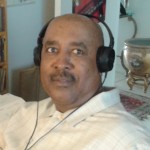BY HOWARD CAMPBELL
Observer senior writer—

With a rapidly growing West Indian community, New York City (NYC)was prime for go-getters from that region during the 1970s. One of them was Clinton Lindsay, a Jamaican who moved to The Bronx in January 1974.
Lindsay, who is from Spanish Town, has been a staple on West Indian radio for 36 years. He currently hosts The Foundation Mondays to Fridays, from noon to 3:00 pm, on Foundation Radio Network in South Florida.
Lindsay moved to the Sunshine State in 2002 after a successful run in The Big Apple.
The main feature on his show is an influential top 30 chart which he boasts is the “longest running ethnic reggae chart in the US”.
While pioneer NYC Jamaican broadcasters like Ken Williams and Gil Bailey are credited with introducing roots reggae to the Tri-State area in the 1970s, Lindsay made his mark breaking a more rebellious sound a decade later.
“Before me, dancehall music was barely embraced by others on radio. My first public broadcast was on WHBI (later WNWK 105.9 FM) on October 7, 1982, and from there I made it my mission to give dancehall music and its components a platform,” he explained. “Coming to New York was a big part of giving them that exposure/platform, so I learned the US work permit procedures and that’s how my journey began.”
Dancehall music exploded in the early 1980’s in Kingston. But the first place it caught fire overseas was London, where top music producers like Henry “Junjo” Lawes had a distribution deal with Greensleeves Records. In the United States, there was no such source.
Lindsay claims that through his radio shows dancehall heavyweights got a foothold in the US East Coast market. By the late 1980’s and early 1990’s, artistes such as Shabba Ranks, Super Cat, Papa San, Chaka Demus and Pliers, Lt Stitchie, Richie Stephens, Tiger, Cocoa Tea, Sanchez, Cutty Ranks, Early B, Lady G, Sister Charmaine, Patra, Mad Cobra, Admiral Bailey, Pinchers, Peter Metro, Half Pint and Junior Reid were performing regularly in New York and neighboring New Jersey and Connecticut.
The top 30 chart which he introduced in October 1975 helped significantly. Lindsay’s weekly tally is a staple on West Indian radio and sometimes paves the way for songs that only got played at dances to break into mainstream charts.
Lindsay, 61, actually migrated to Toronto, Canada, in late 1973. He moved to New York one month later, settling in The Bronx, a West Indian stronghold, and attending New York Institute of Technology where he earned a degree in communication arts.
Moving to South Florida, he established LYNKS FM, a community station which ended in 2010 after five years on the air.
Regional radio has evolved significantly since he moved to the US 44 years ago.

“The advance of technology has opened it to all sorts. One time, you had to have some basic training to be on the air; today, it is not so. However, there are still a few professionals around you just have to search for them,” he said.
With the advent of the Internet, artistes, music producers and lifestyle promoters can expose their product through diverse social media. Still, Clinton Lindsay believes there is room for the West Indian radio station.
“Terrestrial radio is very much relevant to Jamaican/West Indian communities in America, especially for the older generation. Caribbean nationals are historically a radio-driven people, and most of them are not up to speed with the Internet and other social media settings,” he said. “The quickest and most effective way to reach the Jamaican/Caribbean market is through broadcast radio!”



You must log in to post a comment.